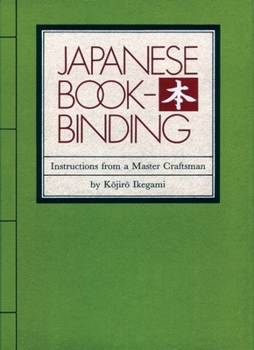Japanese Bookbinding: Instructions from a Master Craftsman
A third-generation traditional bookbinder gives easy-to-follow instructions for making all the major, historically important styles of Japanese bindings as well as traditional book cases--the... This description may be from another edition of this product.
Format:Hardcover
Language:English
ISBN:B007CZ3YN6
ISBN13:9780834801967
Release Date:June 1986
Publisher:Weatherhill
Length:148 Pages
Weight:1.60 lbs.
Dimensions:0.8" x 7.7" x 10.5"
Customer Reviews
5 ratings
Brilliant!
Published by Thriftbooks.com User , 16 years ago
I was interested in bookbinding, and loved the simplicity and elegance of japanese books. When I got the book, was easy to read and very simple instructions; In less of two weeks already made a Yotsume toji, a kikko-toji and a flutter bindings. It is a very useful book for people never attempt BB before, because japanese books have less pages and require less steps than traditional western books. No mention the creative ways of the different types of books can be made.
At the Master's Feet
Published by Thriftbooks.com User , 19 years ago
As an amatuer bookbinder with varying levels of attention span, I found this book really useful. The illustrations and directions are very clear and can be followed very closely or used as a jumping off point. It covers many styles of binding, tools and paper. I especially enjoyed the pictures where the bookbinder's foot is used to to hold something down leaving the hands free to work. Ever read a craft how-to book and thought...well I could do that if I had 3 hands?
Lots of choices, clear directions
Published by Thriftbooks.com User , 19 years ago
This is an excellent introduction to the varied forms of Japanese bookbinding. As with so many other crafts in Japan, it is both like and very unlike matching Western craft. First, there is the wide variety of different binding styles. Some are very distinctive. In the accordion and 'flutter' books, the first and last pages are bound to the covers. The rest of the pages are fan-folded, either one long strip or sheets pasted together. Other bindings, whether Chinese, Korean, or uniquely Japanese in style, tie or glue the pages into a more Western stack. The end of this book shows traditional outer covers for books, partial or complete boxes. The are made uniquely for each volume or set, to give it additional protection. The tools, materials, and techniques are laid out clearly. The authors show first show the traditional craft, as it has been practiced since the Heian era (ca. 1000 AD). They also show how modern materials can be used instead of or in addition to the older ones. The technique for each binding or box is spelled out in clear pictures and text. Clear technique is what makes this book. It gives the scholar a good understanding of how a master artisan would prepare or repair each artifact. It also gives the home crafter the ability to adapt classic techniques to modern uses, from keepsake albums to collections of a child's art. The structure of most Japanese books is simple enough for a child to imitate with some kind of success, even though the book's examples approach museum quality. With a little thought, the techniques can be adapted to almost any level of skill. This is book is very enjoyable, even if you just read it. If you go ahead and try some of the techniques shown, you'll enjoy it even more. You may even get results that you'll enjoy for years to come. //wiredweird
Japanese Bookbinding an excellent teaching tool
Published by Thriftbooks.com User , 22 years ago
As a professional artist I found the step by step instructions and black and white photos and drawn illustrations to be exceptional. Each part of the craft of book making including the proper tools and glues for the job are described in easy detail. A variety of Japanese style books are included in this book. A valuable addition to the library of a paper craftsman.
Excellent and complete resource on Japanese Bookbinding
Published by Thriftbooks.com User , 24 years ago
After a brief history of bookbinding in Japan, Ikegami gives wonderful details of the tools and methods of bookbinding. Covering the tools and materials, he not only shows and details the classical, but lists more accessible western tools and materials that can be used as well. Ikegami begins covering the actual methods of bookbinding with a section on the basic techniques used. What follow are detailed descriptions of the construction of 19 different book styles, grouped into categories ( Four-Hole, Accordian, Ledgers, Other.) The last chapters cover the construction of book cases and the book mending using Japanese techniques. Finally appendices include an extensive Selected reading list (with both English and Japanese titles), and a suppliers list. Throughout the book the numerous illustrations are extremely clear, and used to show the step by step construction of the books. The text accompanying them is detailed and clear. 8 pages of full page, color plates show each of the books described in the text.This book has found a permanent spot on my studio bookshelf, and has in fact prompted me to renew my own love affair with Japanese books. I have already completed two projects, with nice results, after only 1 week with copy of this book from the library. Ordered my own copy today.





